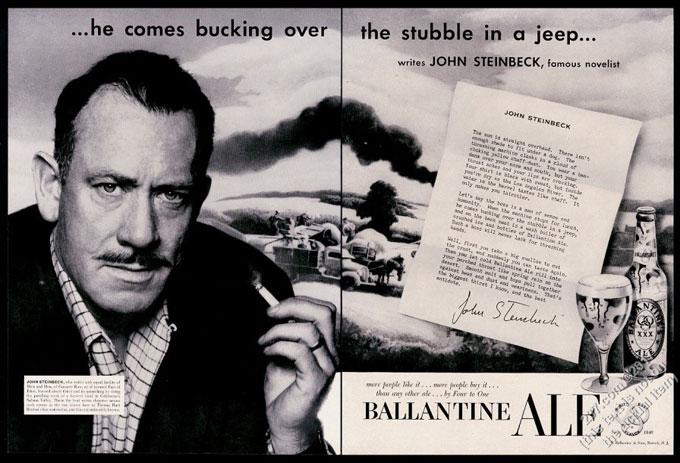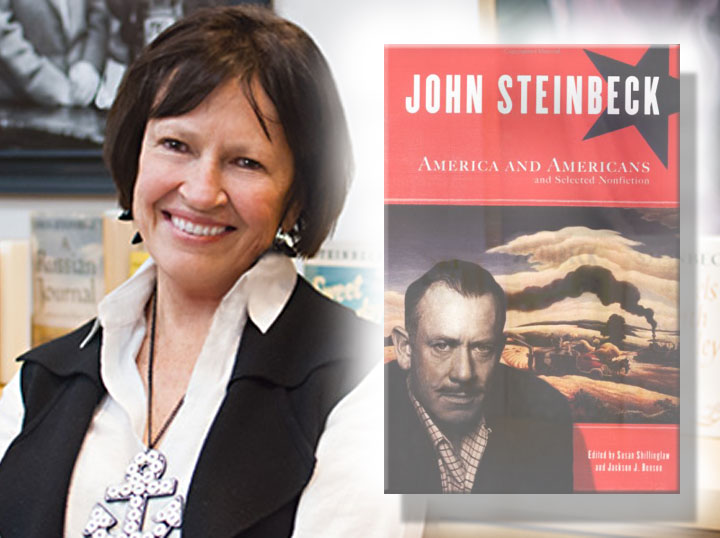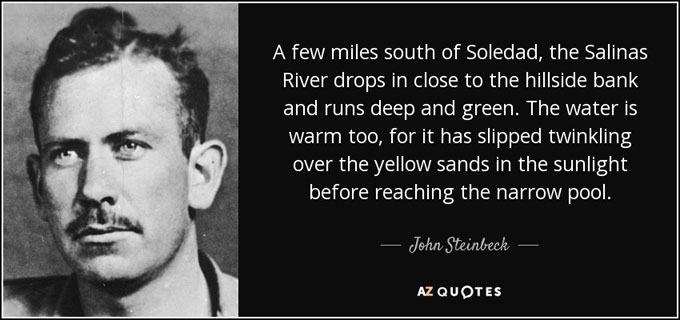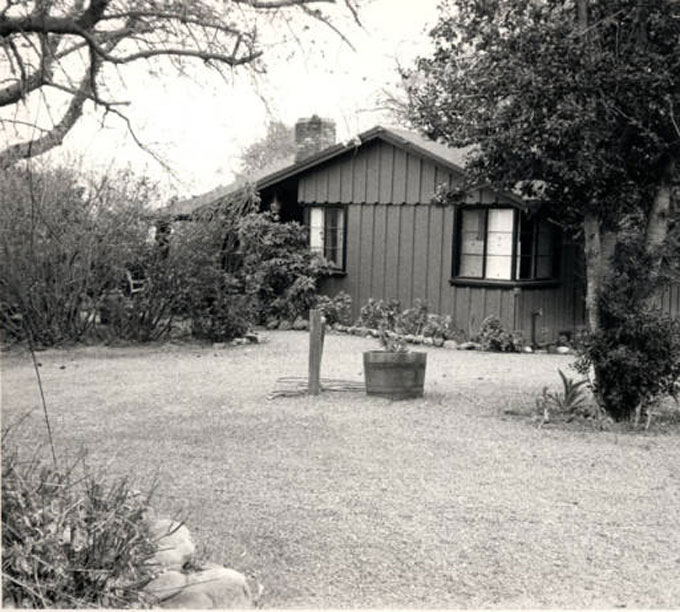Identity politics aside, quoting John Steinbeck out of context is an act of cultural appropriation calling for correction when the interest being served is one Steinbeck criticized in his writing. Ballantine Ale benefited from his endorsement in this 1953 advertisement, true, but the author of The Grapes of Wrath distrusted big business and condemned consumerism in Travels with Charley and The Winter of Our Discontent. “If I wanted to destroy a nation,” he confided to Adlai Stevenson in 1959, “I would give it too much and I would have it on its knees, miserable, greedy and sick.” Forbes magazine had been defending corporate power and prestige for decades when Steinbeck wrote his letter to Stevenson, and our so-called business president began his career as a serial liar by gaming his score on the magazine’s annual wealthiest-list in the 1980s. Reason enough to object to today’s cultural appropriation of John Steinbeck’s advice to budding writers by the expert who posted “How to Use Targeted Content Marketing to Gain More Customers” at the magazine’s online edition for budding entrepreneurs: “Remember that great outreach is an act of storytelling. As author John Steinbeck wrote, “Forget your generalized audience. In the first place, the nameless, faceless audience will scare you to death and in the second place, unlike the theater, it doesn’t exist. In writing, your audience is one single reader.” If you wanted to destroy a nation in 2018, having Donald Trump for president and Forbes magazine for literary light would be a sobering way to start.
Archives for April 2018
John Steinbeck’s Women in Sag Harbor and Salinas
The village setting of The Winter of Our Discontent closely resembles Sag Harbor, the Long Island town where John Steinbeck liked to loaf and write, and the women in The Winter of Our Discontent reflect aspects of the women in Steinbeck’s personal life, the focus of the 2018 Steinbeck Festival in Salinas, the California town where the author of The Winter of Our Discontent grew up with a sister named Mary and a girl from church who went on to marry a man named Hawley. Susan Shillinglaw wrote the introduction to the Penguin Classics edition of The Winter of Our Discontent and conceived of the idea for this year’s Steinbeck festival, so there’s a pleasant symmetry to the May 18-20 celebration of the novel being planned in Sag Harbor, where Shillinglaw (in photo) will lead public discussion and the book will be read aloud, cover to cover, at Canio’s Cultural Café. Salinas and Sag Harbor were bookends in the life of John Steinbeck. So were the trio of Marys from Steinbeck’s family and the family of the novel’s hero Ethan Hawley—Steinbeck’s beloved sister; Ethan’s steadfast spouse, and the enlightened daughter who prevents his discontent from becoming despair. The temptress in Ethan Hawley’s tale also has a correlative in Steinbeck’s personal history. To find out who she was, sign up for the May 4-6 celebration of The Women of Steinbeck’s World and note whose name is missing from the honor roll. If Long Island is more convenient, show up for the May 18 talk by Susan Shillinglaw, the link between Steinbeck’s Sag Harbor and Salinas, and ask.
Art of the River That Runs Through Steinbeck’s World
John Steinbeck’s love affairs with women, the fine arts, and the Salinas River valley come together at the 2018 Steinbeck Festival in Salinas, California when the artist and writer Janet Whitchurch talks about Underground and Running North, a new fine art book featuring her images and text. Sponsored by the National Steinbeck Center, “The Women of Steinbeck’s World” runs Friday, May 4 through Sunday, May 6 in Salinas, Monterey, and Pacific Grove and includes daytime lectures and tours, after-hour social events, and an art-feature talk by Whitchurch about the local river that inspired her book—and, like the women in his world, both inspired and frightened John Steinbeck, whose lifelong love affair with fine art and writing was fortunately less ambivalent. Don’t miss out on the variety and fun. Purchase your ticket today.
Not John Steinbeck’s View
Purple sofas, 4,000 square feet, and an elevated view of midtown may make the New York apartment where John Steinbeck died in 1968 a bargain at $5 million, as asserted in the sale listing for 190 East 72nd Street, but the stark contrast with Steinbeck’s unvarnished view of the world in 1938 will not have escaped thoughtful readers of The Grapes of Wrath. A house is not a home if you’d rather be somewhere else, and Steinbeck preferred the little getaway he and his wife Elaine bought way out on Long Island because he preferred small towns, small houses, and doing his writing without a distracting view, however elevated. When Elaine Steinbeck died, new owners doubled the space of the apartment and added bedrooms and bathrooms (six of each) but kept the roll-top desk used by Steinbeck and offered as part of the sales pitch. But a sales picture is worth a thousand words. Compare the hard lines and assertive scale of the souped-up, for-sale living room, with its massive, grape-purple sofas and $5-million view, and the solitary appeal of the modest house where Steinbeck wrote The Grapes of Wrath—an unvarnished depiction of the stark contrast, then and now, between people with no home and those who live in glass houses but insist on throwing stones.
Photo of John Steinbeck’s Santa Cruz mountain home courtesy Los Gatos Public Library
Looks Like Tom Joad and Sings Like Woody Guthrie
 John Craigie speaks from experience about the title of his recently released tour recording John Craigie Live: Opening for Steinbeck. The soft-spoken West Coast singer-songwriter explains that performing as a warm-up act is like “having to read a short story by another author before getting to a work by John Steinbeck,” an artist who understood the perils of playing second fiddle. A born-and-bred Californian with the face of a sweet Tom Joad and the voice of a young Woody Guthrie, Craigie combines folk music, stand-up comedy, and situational storytelling to elicit the kind of audience response espoused by Steinbeck from listeners—to judge from the live recording—who are with him all the way on the perils of presidents named Trump and books named Leviticus. “The storytelling enables listeners to relate,” says Craigie, who majored in math at UC-Santa Cruz and got his start singing and playing in a band called Pond Rock. “Really good music doesn’t make you feel good,” he adds, echoing John Steinbeck on why he wrote fiction. “It makes you feel like you’re not alone.” Sample the track, then buy a signed CD of John Craigie Live: Opening for Steinbeck. (Photo of John Craigie by Bradley Cox)
John Craigie speaks from experience about the title of his recently released tour recording John Craigie Live: Opening for Steinbeck. The soft-spoken West Coast singer-songwriter explains that performing as a warm-up act is like “having to read a short story by another author before getting to a work by John Steinbeck,” an artist who understood the perils of playing second fiddle. A born-and-bred Californian with the face of a sweet Tom Joad and the voice of a young Woody Guthrie, Craigie combines folk music, stand-up comedy, and situational storytelling to elicit the kind of audience response espoused by Steinbeck from listeners—to judge from the live recording—who are with him all the way on the perils of presidents named Trump and books named Leviticus. “The storytelling enables listeners to relate,” says Craigie, who majored in math at UC-Santa Cruz and got his start singing and playing in a band called Pond Rock. “Really good music doesn’t make you feel good,” he adds, echoing John Steinbeck on why he wrote fiction. “It makes you feel like you’re not alone.” Sample the track, then buy a signed CD of John Craigie Live: Opening for Steinbeck. (Photo of John Craigie by Bradley Cox)






